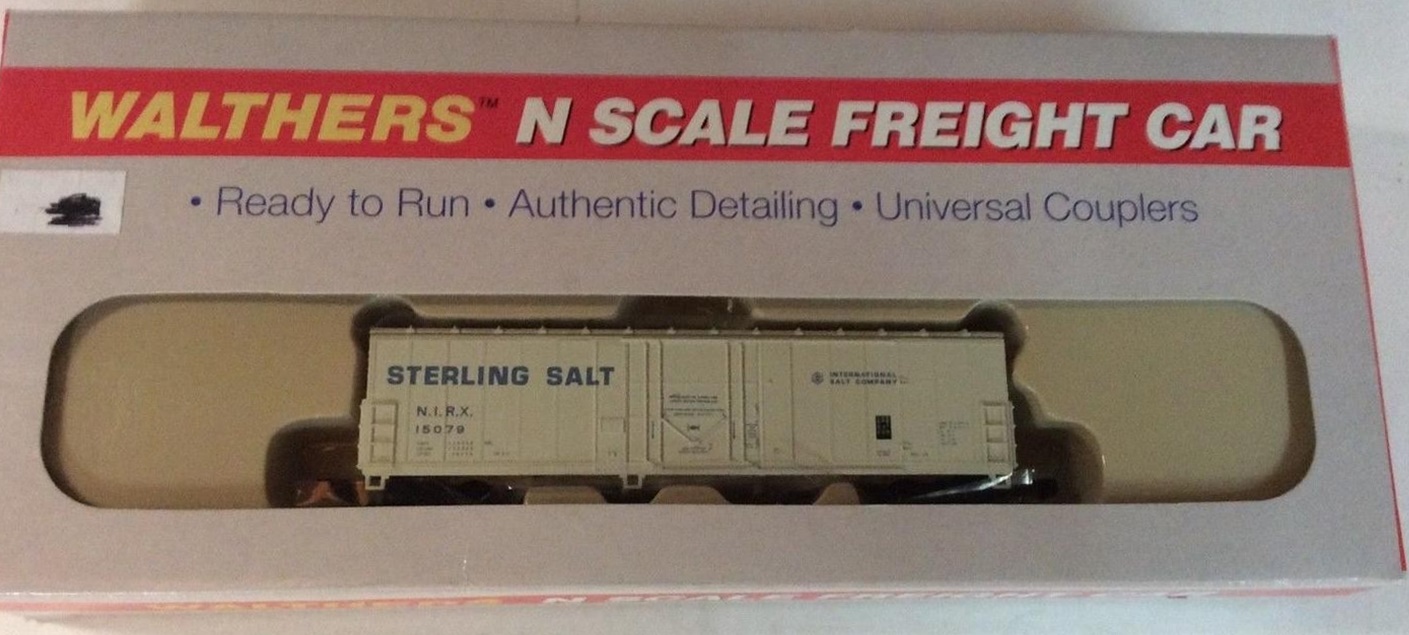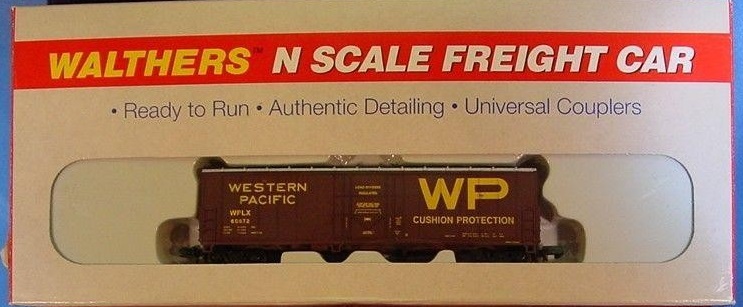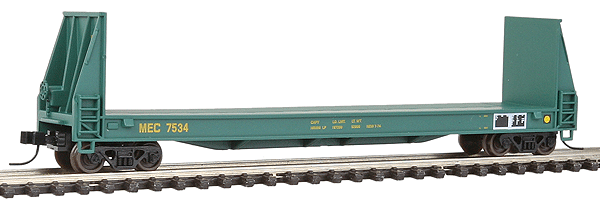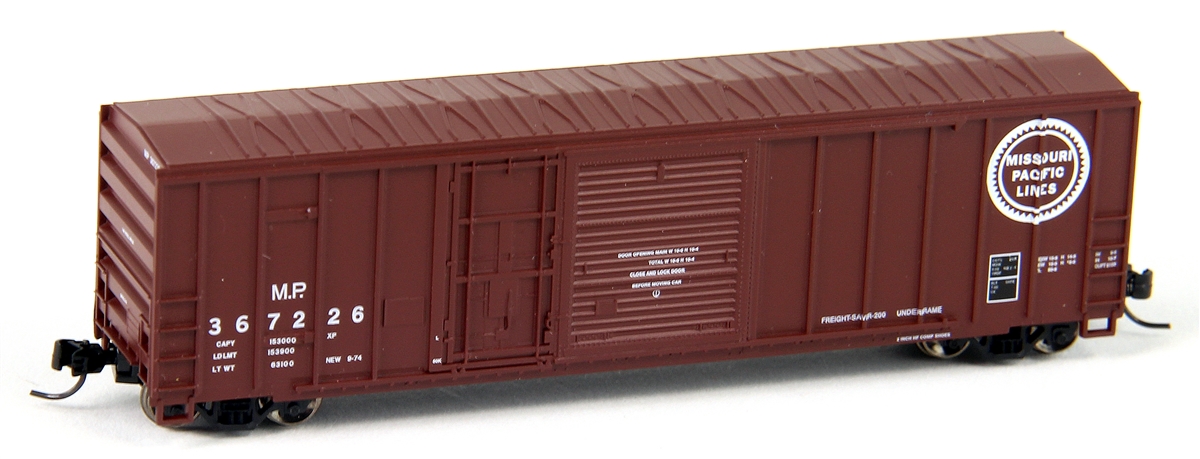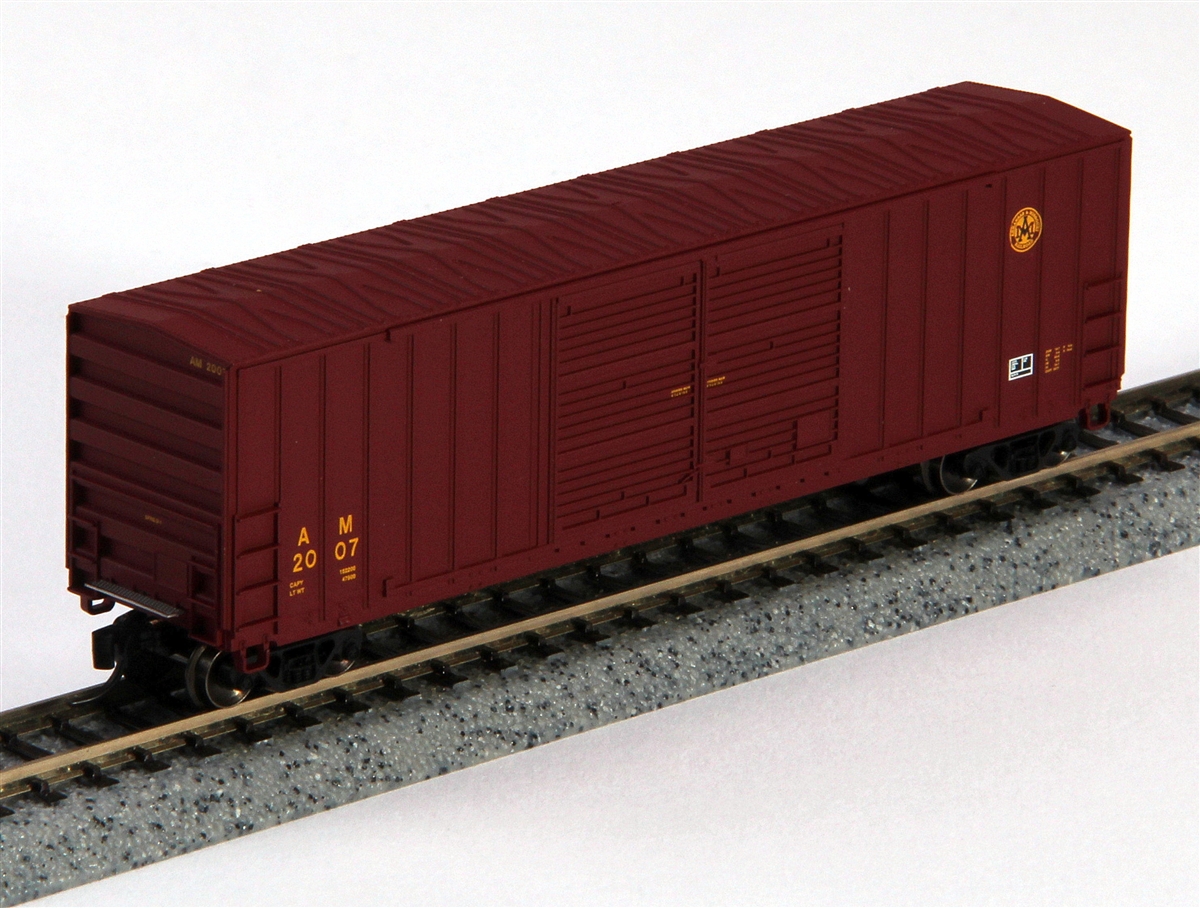Model Information: This model was designed by Walthers and produced in China starting in the late 1980s or 1990s. They do not appear in my 1997 catalog, but based on the stock numbers they seem to be something that they stopped making before 1997 rather than started making after 1997. The tooling is fairly simple and typical of a 1st generation car but with 2nd generation printing. One thing that makes these different is that the roof is attached to the body. The sides and underframe are all one piece. Most other rolling stock (especially boxcars) have the body attach to the underframe. One advantage of this design is it is fairly easy to add weight to the cars. They also allow for a simple swap out of the trucks and couplers using a standard truck pin.
Re-run under Atlas brand in 2019 as "NACC 50' Smoothside RBL Car" after Atlas purchased the tooling from Walthers.
RBL is the AAR class for an insulated bunkerless refrigerator car with loading devices.
Re-run under Atlas brand in 2019 as "NACC 50' Smoothside RBL Car" after Atlas purchased the tooling from Walthers.
RBL is the AAR class for an insulated bunkerless refrigerator car with loading devices.
Prototype History: The 50-foot boxcar made its first appearance in the 1930s and steadily grew in popularity over the years, which further improved redundancies by allowing for even more space within a given car. Today, the 50-footer remains the common boxcar size. After the second world war ended, and steel became once again readily available, steel became the go-to choice for construction of boxcars. Pullman Standard and ACF were some of the most prolific builders of these cars.
In the 1960s, the flush, "plug" style sliding door was introduced as an option that provides a larger door to ease loading and unloading of certain commodities. The tight-fitting doors are better insulated and allow a car's interior to be maintained at a more even temperature.
In the 1960s, the flush, "plug" style sliding door was introduced as an option that provides a larger door to ease loading and unloading of certain commodities. The tight-fitting doors are better insulated and allow a car's interior to be maintained at a more even temperature.
Road Name History: 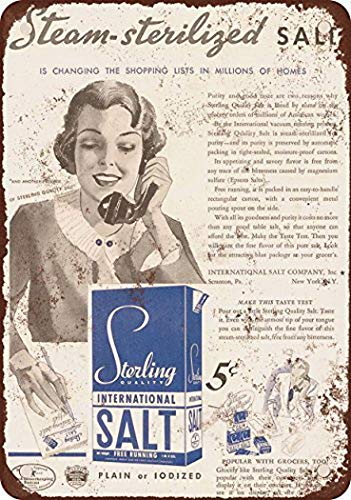 The International Salt Company incorporated on August 22, 1901, and in 1902, the company purchased the stock and assets of the National Salt Company, which had failed. By 1934, International Salt was a holding company for six subsidiaries: Avery Salt Company (West Virginia), Detroit Rock Salt Company (Michigan), Eastern Salt Company (Massachusetts), Independent Salt Company (New York), International Salt Company, Inc. (New York), and Retsof Mining Company (New York). All of the subsidiaries operated rock salt mines and evaporated salt plants and distributed salt. In 1940, the International Salt Company decided to sell four of its subsidiaries--Avery Salt Company, Detroit Rock Salt Company, International Salt Company, Inc., and Retsof Mining Company.
The International Salt Company incorporated on August 22, 1901, and in 1902, the company purchased the stock and assets of the National Salt Company, which had failed. By 1934, International Salt was a holding company for six subsidiaries: Avery Salt Company (West Virginia), Detroit Rock Salt Company (Michigan), Eastern Salt Company (Massachusetts), Independent Salt Company (New York), International Salt Company, Inc. (New York), and Retsof Mining Company (New York). All of the subsidiaries operated rock salt mines and evaporated salt plants and distributed salt. In 1940, the International Salt Company decided to sell four of its subsidiaries--Avery Salt Company, Detroit Rock Salt Company, International Salt Company, Inc., and Retsof Mining Company.
John M. Avery discovered rock salt at Petite Anse, Louisiana in 1862. Petite Anse Island was renamed Avery Island in the late 19th century. Ownership and mining of salt at Petite Anse involved numerous parties until 1886, when New Iberia Salt Company took over operations. In 1896, the Avery family began operating the mine, and they founded the Avery Rock Salt Mining Company. In 1899, the International Salt Company leased the mine.
The Detroit Salt and Manufacturing Company was founded in 1906. The company quickly went bankrupt during construction of a shaft and was acquired in 1910 by the Watkins Salt Company, which incorporated the new organization under the name Detroit Rock Salt Company. The company experienced success and the International Salt Company purchased the mine circa 1914. In 1983, International Salt closed the mine's operations and in 1985, Crystal Mines, Inc., purchased the mine as a potential storage site.
In 1885 the Empire Salt Company of New York was renamed the Retsof Mine Company, and the Village of Retsof was founded near the mine shaft. During the next 110 years, the mine grew to become the largest salt-producing mine in the United States and the second largest in the world. Before the initial collapse in March 1994, the mine encompassed an underground area of more than 6,000 acres, and the mine footprint (outer edge of mined area) extended over an area of nearly ten square miles. At the time of the collapse, the Retsof Mine was owned by Akzo-Nobel Salt Incorporated (ANSI) and, during the winter of 1993–1994 operated at full capacity to meet demands for road salt throughout the northeastern United States. The Retsof Mine ceased operations on September 2, 1995, and by December, twenty-one months after the initial collapse, the mine was completely flooded.
Sterling Salt was one of trademarks of The International Salt Company.

John M. Avery discovered rock salt at Petite Anse, Louisiana in 1862. Petite Anse Island was renamed Avery Island in the late 19th century. Ownership and mining of salt at Petite Anse involved numerous parties until 1886, when New Iberia Salt Company took over operations. In 1896, the Avery family began operating the mine, and they founded the Avery Rock Salt Mining Company. In 1899, the International Salt Company leased the mine.
The Detroit Salt and Manufacturing Company was founded in 1906. The company quickly went bankrupt during construction of a shaft and was acquired in 1910 by the Watkins Salt Company, which incorporated the new organization under the name Detroit Rock Salt Company. The company experienced success and the International Salt Company purchased the mine circa 1914. In 1983, International Salt closed the mine's operations and in 1985, Crystal Mines, Inc., purchased the mine as a potential storage site.
In 1885 the Empire Salt Company of New York was renamed the Retsof Mine Company, and the Village of Retsof was founded near the mine shaft. During the next 110 years, the mine grew to become the largest salt-producing mine in the United States and the second largest in the world. Before the initial collapse in March 1994, the mine encompassed an underground area of more than 6,000 acres, and the mine footprint (outer edge of mined area) extended over an area of nearly ten square miles. At the time of the collapse, the Retsof Mine was owned by Akzo-Nobel Salt Incorporated (ANSI) and, during the winter of 1993–1994 operated at full capacity to meet demands for road salt throughout the northeastern United States. The Retsof Mine ceased operations on September 2, 1995, and by December, twenty-one months after the initial collapse, the mine was completely flooded.
Sterling Salt was one of trademarks of The International Salt Company.
Brand/Importer Information: Wm. K. Walthers, Inc., was founded in Milwaukee in 1932 -- but really, it started years earlier, when seven-year-old Bill Walthers got his first taste of the hobby with a small, wind-up toy train for Christmas. He continued with the hobby and eventually had an attic layout comprised primarily of his own scratch-built creations. After he wrote a series of articles on building train control and signaling systems, he got so many letters from other modelers that he began manufacturing them. The first ad (in the May issue of The Model Maker) offered a 24-page, 15c catalog that listed rail, couplers, and electrical supplies. Sales were over $500.00 for the first year, and the fledgling company was off to a strong start.
Within five years, Walthers had grown so much that larger quarters were needed. Space was found on Erie Street, where everything -- from milled wood parts to metal castings to decals -- was made in-house. 1937 also saw a new line in HO Scale, featured in its own catalog. Bill brought operating layouts to the 1939 World's Fair, which gave the hobby a big boost. Soon, though, the growing possibility of war overshadowed these successes, and supplies were becoming increasingly difficult to obtain.
During the war, model manufacturers were ordered to stop production in order to conserve critical metal supplies. Walthers produced what it could from nonessential materials. A series of ads in 1943 saw Bill literally scraping the bottom of a barrel! The postwar boom meant rapid growth for the hobby; however, small homes and new families left no room for O scale layouts, and many modelers moved to HO Scale.
The next twenty years brought great change. In 1958, Bill retired and his son Bruce took over. Just as full-size railroads were being hard-hit by new technology, so too were model railroads. Leisure time was spent in front of the TV set, not the train set. In 1960, Walthers became a full-line distributor of other manufacturers' products while continuing expansion of the Walthers lines. By the start of the 1970's, business was booming again, and Bruce's son Phil joined the company.
Expansion and diversification continue under Phil's tenure. The establishment of the Walthers Importing Division added several international lines. The manufacturing plant was modernized. Code 83 track was introduced in 1985, giving layouts more realistic proportions. In 1990, the Cornerstone Series buildings were unveiled. Combining a freight car with a related industry, the Cornerstone Series makes it possible for modelers to duplicate authentic operations, enhancing layout realism. The Train Line Deluxe Sets and locomotives debuted in 1994. These sets feature the detailing of serious models and an affordable price -- allowing newcomers to get started, and then build-on to their first set, rather than replacing it.
In 2005, Walthers purchased Life-Like from Lifoam Industries. With this purchase Walthers acquired the Proto Lines that have become the backbone of their locomotive and rolling stock segments.
Today, Walthers continues to expand, improve and develop a wide range of products. Their latest selection can be found throughout Walthers.com and their printed catalogs, along with items from over 300 other manufacturers.
In December 2017, Lowell Smith announced the ‘purchase of tooling’ of the Walthers line of N Scale passenger cars (sleeper, coach and baggage cars), and in June 2018, Atlas announced that it will purchase all N scale locomotive and rolling stock tooling owned by Walthers, including the Walthers N tooling as well as former Life-Like tooling. This divestment puts an end to Walthers involvement as a manufacturer of N scale rolling-stock, though it will continue its range of N scale structures.
Within five years, Walthers had grown so much that larger quarters were needed. Space was found on Erie Street, where everything -- from milled wood parts to metal castings to decals -- was made in-house. 1937 also saw a new line in HO Scale, featured in its own catalog. Bill brought operating layouts to the 1939 World's Fair, which gave the hobby a big boost. Soon, though, the growing possibility of war overshadowed these successes, and supplies were becoming increasingly difficult to obtain.
During the war, model manufacturers were ordered to stop production in order to conserve critical metal supplies. Walthers produced what it could from nonessential materials. A series of ads in 1943 saw Bill literally scraping the bottom of a barrel! The postwar boom meant rapid growth for the hobby; however, small homes and new families left no room for O scale layouts, and many modelers moved to HO Scale.
The next twenty years brought great change. In 1958, Bill retired and his son Bruce took over. Just as full-size railroads were being hard-hit by new technology, so too were model railroads. Leisure time was spent in front of the TV set, not the train set. In 1960, Walthers became a full-line distributor of other manufacturers' products while continuing expansion of the Walthers lines. By the start of the 1970's, business was booming again, and Bruce's son Phil joined the company.
Expansion and diversification continue under Phil's tenure. The establishment of the Walthers Importing Division added several international lines. The manufacturing plant was modernized. Code 83 track was introduced in 1985, giving layouts more realistic proportions. In 1990, the Cornerstone Series buildings were unveiled. Combining a freight car with a related industry, the Cornerstone Series makes it possible for modelers to duplicate authentic operations, enhancing layout realism. The Train Line Deluxe Sets and locomotives debuted in 1994. These sets feature the detailing of serious models and an affordable price -- allowing newcomers to get started, and then build-on to their first set, rather than replacing it.
In 2005, Walthers purchased Life-Like from Lifoam Industries. With this purchase Walthers acquired the Proto Lines that have become the backbone of their locomotive and rolling stock segments.
Today, Walthers continues to expand, improve and develop a wide range of products. Their latest selection can be found throughout Walthers.com and their printed catalogs, along with items from over 300 other manufacturers.
In December 2017, Lowell Smith announced the ‘purchase of tooling’ of the Walthers line of N Scale passenger cars (sleeper, coach and baggage cars), and in June 2018, Atlas announced that it will purchase all N scale locomotive and rolling stock tooling owned by Walthers, including the Walthers N tooling as well as former Life-Like tooling. This divestment puts an end to Walthers involvement as a manufacturer of N scale rolling-stock, though it will continue its range of N scale structures.
Item created by: Alain LM on 2019-07-21 10:27:16. Last edited by Alain LM on 2020-09-22 14:57:11
If you see errors or missing data in this entry, please feel free to log in and edit it. Anyone with a Gmail account can log in instantly.
If you see errors or missing data in this entry, please feel free to log in and edit it. Anyone with a Gmail account can log in instantly.



